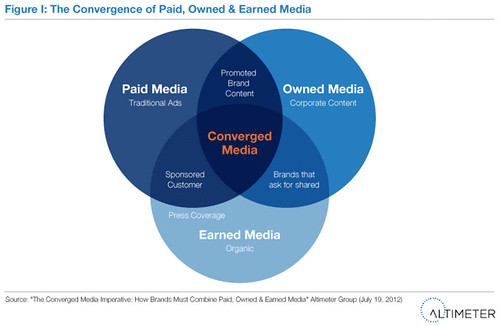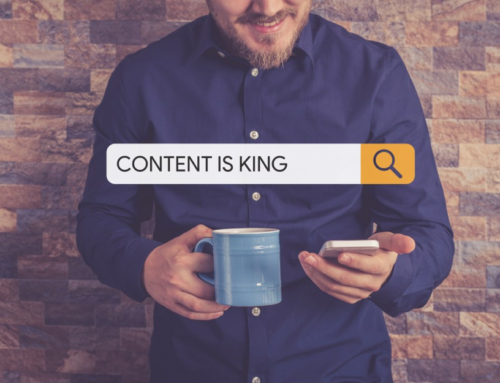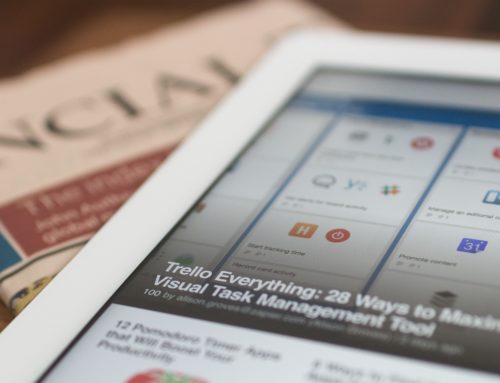Guest post by Geoff Livingston
The concept of converging media continues to heat up, most notably with marketers discussing the dynamics of blending paid, owned and earned media.
While the paid, owned and earned concept has been circulated for quite a while now, it’s becoming a common part of the marketing strategist’s vocabulary.
Paid, owned and earned really provides a budgetary view of how marketers approach media selection. Marketers often silo their marketing choices, and budget is a primary way they do that.
Just to sum up:
Paid is anything the marketing department pays a media or other company for media placement of its message, brand, email or other form marketing. Traditionally this includes ads, SEO and direct marketing buys.
Earned occurs where an customer, individual or media outlet mentions your brand in some form. While some assume the name connotates free media, in reality it often means the organization deploys agencies, PR and social media staff to garner earned media.
Owned is when a company acts like a media organization and publishes its own content, on its site, in print or on social networks. Obviously, financial and staff resources are deployed to create this media.
Siloed thinking about media doesn’t match the customer/stakeholder experience. Instead, the customer/stakeholder navigates hundreds, even thousands of messages everyday.
When a customer sees and hopefully interacts with a brand, they rarely distinguish between ads, owned and even some forms of earned media, assuming corporate messaging, etc. Trust is hard to come by. Accepting marketing really becomes a question of relevancy for customers.
The challenge then becomes how to work from a combined budgetary, strategic and tactical approach for the whole marketing effort to meet that customer experience.
Obviously, this topic gets considerable conversation in Marketing in the Round (which I co-authored with Gini Dietrich). Whether you read the book or not, I hope the converging media environment causes you to turn you head towards a different form of planning. We need to weave tactics and types of media together for a holistic experience rather than isolate them.
It’s a primary topic consideration for any strategic communicator who wants to succeed in the converging media environment.
 Geoff Livingston is an author, public speaker and strategist who helps companies and nonprofits develop outstanding marketing programs. He brings people together, virtually and physically to build loyal networks for business, change and higher knowledge. A former journalist, Livingston continues to write, and has authored three books.
Geoff Livingston is an author, public speaker and strategist who helps companies and nonprofits develop outstanding marketing programs. He brings people together, virtually and physically to build loyal networks for business, change and higher knowledge. A former journalist, Livingston continues to write, and has authored three books.


![[EVENT]: PR Hacks for Small Biz (online)](https://shonaliburke.com/wp-content/uploads/2021/06/FB-Ad-1200x800-01-01-01-Copy-500x383.jpeg)








[…] advertisements, products and other forms of monetization to the mix, a transition occurs. In the paid, earned, and owned model of media, you are moving from earned (natural word of mouth) to owned or paid media. Both of those […]
[…] Livingston wrote a guest blog post on Waxing UnLyrical about understanding paid, owned and earned media. He included this fancy diagram that I think […]
[…] Livingston wrote a guest blog post on Waxing UnLyrical about understanding paid, owned and earned media. He included this fancy diagram that I think […]
I had hoped this would shed light on something that happened recently that confused me, when I sent a PR agency seeking free publicity for a client my full Media Kit, they wrote back and said they weren’t looking to pay, they wanted ‘earned’ coverage. Since I’ve never worked with them before I didn’t understand what on earth they meant by ‘earned’ coverage. How had they already free coverage?
Tracy @ Ascending Butterfly
[…] Understanding Paid, Owned and Earned Media (waxingunlyrical.com) […]
This is a really informative post Geoff. So many lines are blurred now and it is very hard to quantify these types of media now. Whether it be the type or the value of each.
HowieG I agree and I was looking at the top chart, and thinking that reverse arrow should extend to advertising. because its being called into a supporting role more and more frequently!
Good roundup Geoff. I’ve noticed that Facebook has begun to differentiate between organic, viral and paid reach on their posts, partlty as a response to these definitions if I had to guess. And I bet, when users see the post, they don’t know/care about the difference most of the time. However, I wouldn’t necessarily suggest the same is true of earned media in the form of periodical PR and advertisements. Ads I tend to tune out, and when something does get through, I’m annoyed. Media articles still carry some sense of legitimacy with me (although Ryan Holland did a good job kicking those around, so who knows?). Either way, good job distinguishing for the masses. Please come guest post any time!